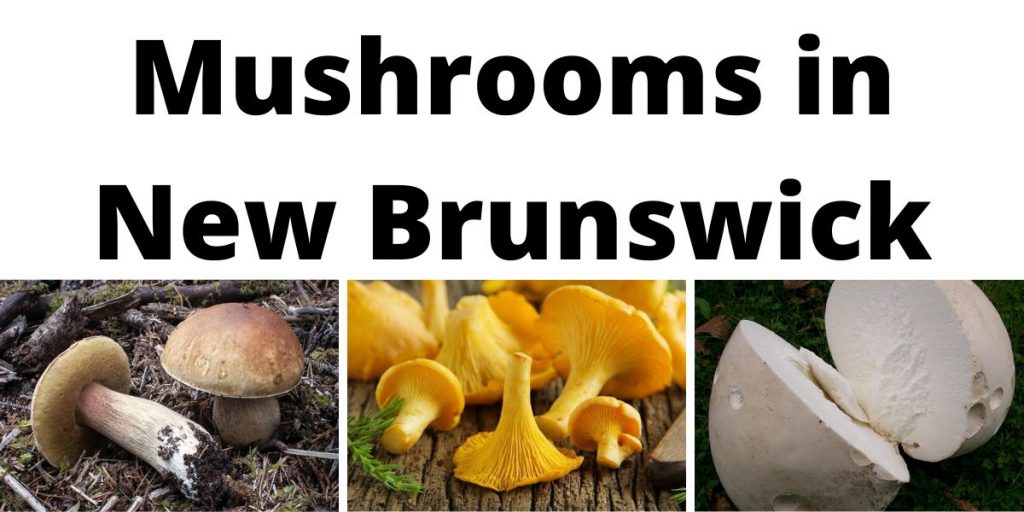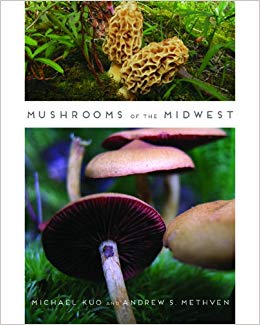New Brunswick[i] is a small but rugged province mostly covered in forest—forest that has grown after much of the original forest of the region was destroyed by logging. Those forests still produce some interesting fungi, for those who know how to look. Of course we cannot list all of New Brunswick’s mushroom species, there are too many, but we can provide a sampling of the province’s diversity[ii][iii].
The following is not an exhaustive list of all edible mushrooms in New Brunswick, nor is it a list of “easy” mushrooms for beginning foragers. In fact, beginners shouldn’t be foraging, not without the guidance of someone experienced. That’s because there are important details that may be obvious to an experienced eye, but a beginner is likely to miss. Instead, we offer this article as an incentive to climb up that learning curve—these are some of the delicacies waiting for you at the top.
The purpose of this list is merely educational and not to be used in place of a field guide, spore prints, or an identification app. Even more preferable is an expert to guide. you in person. If you do end up going out mushroom hunting make sure you take a quality knife with you and a basket/bag for your finds!
Our Recommended Field Guides for New Brunswick
COVER | TITLE | Header | ||
|---|---|---|---|---|
OUR #1 RATED | ||||
Edible Mushrooms
Chanterelles and Friends
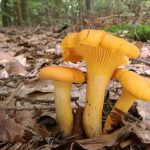

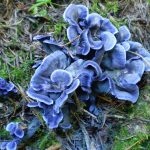



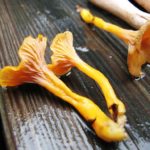

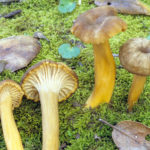

Chanterelles, members of the genus, Cantharellus, are famously delicious and relatively easy to identify. There are also several other genera that are closely related, similar-looking, and also good to eat—and sometimes actually called chanterelles. In fact, there are several species that have been moved back and forth over the tears, so even if they aren’t considered “true chants now, they used to be. New Brunswick has at least seven members of this group.
Except as noted, all of these are roughly trumpet-shaped with ridges or veins rather than gills.
Golden Chanterelle (Cantharellus sp.) is a true chanterelle—yellow, delicious, and justly famous. Unfortunately, it’s also more than one species, and many writers incorrectly use the scientific name of the European species for all of them. We haven’t been able to track down which golden chant lives in New Brunswick, but at least one of them does. Blue Chanterelle (Polyozellus multiplex)[iv] is indeed dark blue—the color will stain anything it touches—and grows in semi-fused-together clusters. Its scent, somewhat like woodsmoke, is subtle but very strong, and utterly unlike that of true chants. Black trumpets (Craterellus sp.) is also actually multiple species. Some make better eating than others, but all are good. New Brunswick has at least one of them. Craterellus ignicolor and Craterellus tubaeformis are broadly similar, yellowish mushrooms with a flavor like the golden but earthier. They are both sometimes called yellowlegs, among other names.
Hedgehog Mushroom (Hydnum repandum) has spines rather than the ridges of chants, but they taste very much like chanterelles and are closely related to them. Scaly Hedgehogs (Sarcodon imbricatus) are a close look-alike and also edible but not very good.
Boletes
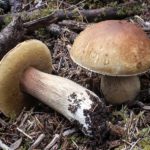

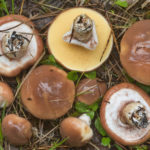

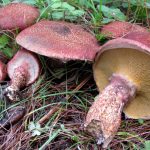



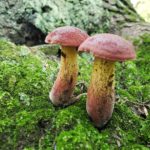

The Boletes are a large group of mushrooms that all have a flat surface pierced by pores rather than gills. Also Boletes are related to each other, no one genus contains all of them. We’re actually not listing them by scientific names at all, since bolete taxonomy is in a state of flux—some get a new name every few years, a confusing state of affairs. Let us know when the dust settles. Not all boletes are safe to eat, but New Brunswick has at least five that are.
The King Bolete group includes multiple species, all of them choice edibles. They are also known as Porcini, and many other names. It’s not clear which king New Brunswick has. The Larch Bolete is common and prolific, but not everybody thinks much of the taste. Some people find it causes stomach upset[v]. The Painted Bolete grows exclusively under white pine trees[vi]. Opinions differ on the taste, but it is edible. The Red-Mouth Bolete is considered choice, but it has poisonous look-alikes[vii]. Bicolor Boletes are red and yellow and considered choice[viii].
Puffballs


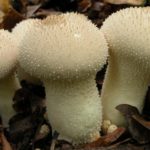



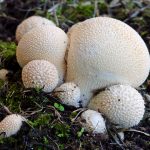

“Puffball” is not a taxonomic category. The word simply refers to all ball-shaped mushrooms that puff out spores at maturity. Some people say all “true” puffballs are edible when young (before the spores start to mature), but that’s just because they’ve decided to consider the inedible ones “false.” That doesn’t seem fair or helpful. It seems better to simply admit that some puffs are not for eating, and that proper identification to species is necessary. New Brunswick has at least four edible puffs.
The Giant Puffball (Calvatia gigantea) is aptly-named; it can reach basketball-size or larger. The main problem is that these have such high protein content that they go bad quickly if not refrigerated, but how do you fit something that big in the fridge? Another option is to dry it and powder it for use is breads and soups. The others are all members of the genus, Lycoperdon. They are small, with a short, thick stalk, and usually short bumps or spines across the surface: Common (L. perlatum), Spiny (L. echinatum), and Pear-Shaped (L. pyriforme).
Ink Caps
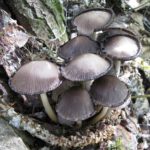

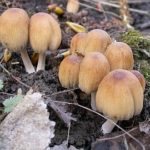

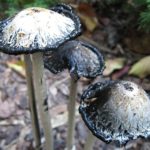

Ink Caps are another group that aren’t particularly related to each other. What they share in common is that as the spores mature the mushroom turns to ink and drips away. Not all species are edible, but several are. Contrary to popular belief, the ink is edible, too—it makes an interesting food dye—though most people prefer to use these before they ink. There are a few that you may see listed as poisonous in some sources but not others. That’s because they contain a substance that is itself harmless, but causes a temporary intolerance to alcohol. If you can abstain from alcohol for a week, these are good eating.
New Brunswick has three edible ink caps: the Inky Cap (Coprinopsis atramentaria), the Mica Cap (Coprinellus micaceus), and the Shaggy Mane (Coprinus comatus).
Mushrooms (Agaricus sp.)
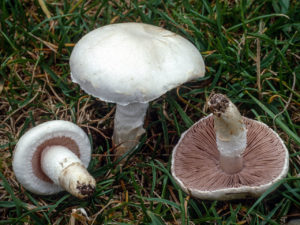

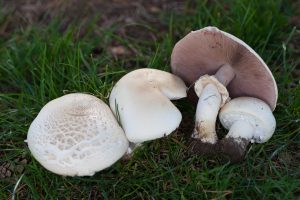

Have you ever wondered why those White Button thingies that go on pizza don’t seem to have a name? They’re called White Button Mushrooms, but “button” isn’t a species, it’s a growth stage. Criminis and portabellos are the same species, but what is the common name of that species?
Turns out, it’s “mushroom.” The word started out as referring to a single kind of fungal fruiting body and then sort of expanded, but the original, official mushroom is still what we put on pizzas and salads, and there are a couple of close wild relatives that look and taste very similar (as well as a couple of close look-alikes that are unpalatable or poisonous). New Brunswick has at least two of these edible, wild “true mushrooms,” the Meadow Mushroom (Agaricus campestris) and the Horse Mushroom (Agaricus arvensis).
Brittlegills (Russula sp.)
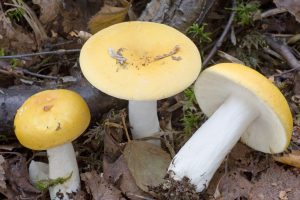

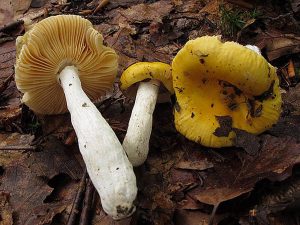

The Russula genus includes some well-known poisonous members, but several are good to eat. The Yellow Swamp Brittlegill (Russula claroflava) is pale yellow and white and does live in certain types of wetland[ix]. Reportedly it pairs well with meat. The Yellow-Gilled Brittlegill (Russula lutea) is also white and yellow, though it does not frequent swamps[x]. Reportedly, it has an apricot-like scent.
Saffron Milk-cap (Lactarius sp.)
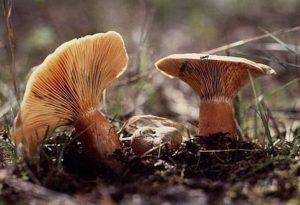

Saffron Milk-Caps[xi] are a group of mushrooms once considered a single species; all are orange, bruise green, and ooze orange liquid when cut. We have not been able to track down which species New Brunswick has. These mushrooms are especially good fried golden-brown.
Apricot Jelly Fungus (Guepinia helvelloides)
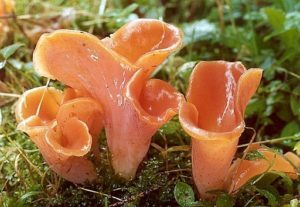

Apricot Jelly is pink, trumpet-shaped, smooth, and firmly gelatinous. Its taste is pleasant, but far from intense—the main reason to eat this one is texture[xii].
Our Recommended Field Guides for New Brunswick
COVER | TITLE | Header | ||
|---|---|---|---|---|
OUR #1 RATED | ||||
Poisonous Mushrooms
Most mushrooms are not poisonous, and most of those that are cause only mild illness—but the consequences of eating one of the few exceptions could be dire! There is no trick or short-cut to figuring out which mushrooms are poisonous—many people think there are, offering rules of thumb meant to make foraging easier and safer. ALL of these rules have exceptions, and following them will eventually make you sick. The fact is that there is NO way to know if a mushroom is edible without first figuring out exactly what it is and looking it up.
The following list is not exhaustive, it’s just a few of the poisonous species in New Brunswick.
Deadly Galerina (Galerina marginata)
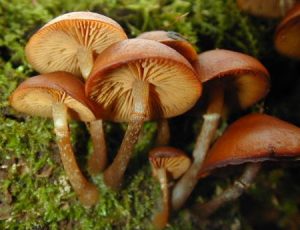

The Deadly Galerina, also called the Funeral Bell, is aptly-named; its poison will kill most humans who eat it, even with prompt medical attention. That the poison can take a day or more to take effect just makes diagnosis harder.
Deadly Galerina is small, brown, and non-descript. So are many culinary mushrooms and most of the magics. Worse, they can grow together with some of their look-alikes in mixed clumps. They key is to identify every single mushroom headed for a human mouth—never make assumptions.
Destroying Angel (Amanita bisporigera)
There are multiple Destroying Angel species, all of them large, handsome, white or whitish mushrooms. This is the one in New Brunswick. Destroying angels have the same poison as the Deadly Galerina, and while they look like they should be easy to recognize, in fact they can be mistaken for virtually every white mushroom out there, including several popular edibles. It’s important to never give way to complacency or overconfidence.
Earthball (Scleroderma sp.)
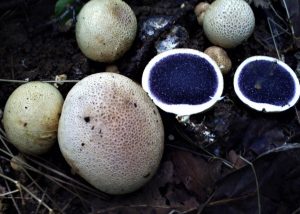

Earthballs are a type of poisonous Puffball. Eating one isn’t deadly, merely regrettable. They differ from edible puffballs most obviously in being more firm, like a rubber ball rather than a marshmallow. The skin is also thicker and tougher, and the interior starts to turn dark much earlier.
Red Russulas (Russula sp.)
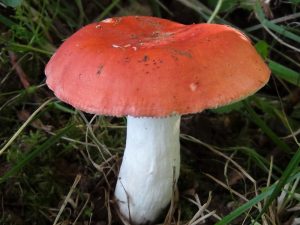

Several Brittlegill species are white below and some red or reddish color above. At least some of these are poisonous—again, not deadly, just regrettable. Some others are just way too hot and acrid to eat. Identifying red Russulas to species is essentially impossible. Not only are these mushrooms very similar to each other, but it seems quite possible that the taxonomy of the group is badly muddled[xiii]. Perhaps it’s best to just call all of them Red Russulas and leave them alone.
Webcaps (Cortinarius sp.)
Webcaps get their name from the webby partial veil that protects the gills until they mature (and then largely disappears.. There are many different kinds, several of which live in New Brunswick. Not all of them are poisonous—in fact, we’ve been unable to confirm whether any of the Province’s webcap species are poisonous. However, the group does include deadly species, and many are of unknown status. Most experts recommend treating all webcaps as potentially dangerous.
Our Recommended Field Guides for New Brunswick
COVER | TITLE | Header | ||
|---|---|---|---|---|
OUR #1 RATED | ||||
Magic Mushrooms
There are not a lot of psychoactive mushroom species in New Brunswick, but there are a few[xiv]. That doesn’t mean foraging for them is a good idea. Aside from the fact that doing so is still illegal[xv], they all look more or less similar to The Deadly Galerina. People have died from making that specific mistake. Also, the various magic mushroom species look more or less like each other, which could cause a problem if you mistook something high-potency, like liberty caps, for something low-potency and took far more than you’d intended.
Not that proper identification is impossible, far from it. And there are definite advantages to foraging for these mushrooms rather than buying or growing them, once you learn how. Just please remember that familiarity with mushrooms as a user—or even as a grower—does not automatically translate to expertise in foraging. To know, you must first learn.
Gymnopilus sp.
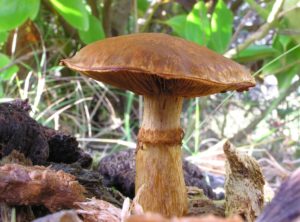

This is a species complex within the Gymnopilus genus, or rustgills. They are psychoactive, but there isn’t much published information on what using them is actually like. The nickname “Laughing Gym” has been applied to some of them, though, so that may be considered a good indication,
Banded Mottlegill (Panaeolus cinctulus)
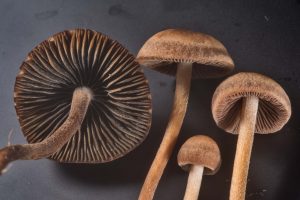

The mottlegills are so called because their spores develop unevenly, producing dark patches on the gills. The genus includes both potently psychoactive and totally inactive members. The banded mottlegill is moderately active and very widespread.
Psilocybe sp.


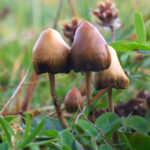

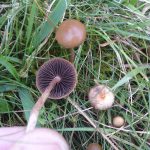

When it comes to Psilocybin Mushrooms, these are generally the go-to choice. For some reason, this genus, despite being much-talked-about for its psychoactive mushrooms, seems not to have a common name of its own. Although its best-known member, P. cubensis, does not grow wild in New Brunswick, two others do: the famous Liberty Cap (P. semilanceata) and the highly-variable P. fimetaria[i].
Our Recommended Field Guides for New Brunswick
COVER | TITLE | Header | ||
|---|---|---|---|---|
OUR #1 RATED | ||||
References:
[i] (n.d.). Psilocybe fimetaria (P.D. Orton) Watling. Shroomery
[i] (n.d.). New Brunswick. Wikipedia
[ii] (n.d.). Mushrooms of New Brunswick. iNaturalist
[iii] (n.d.). Wild Edible Mushrooms of New Brunswick. Northern Bushcraft
[iv] Bergo, A. (2019). The Blue Chanterelle: Polyozellus multiplex. Forager/Chef
[v] (n.d.). Suillus grevillei (Klotzsch) Singer—Larch Bolete. First Nature
[vi] Dino (2018). Mushroom of the Month. June 2018: Painted Suillus, Suillus spraguei. The University of North Carolina Press Blog
[vii] (2023). Boletus subvelutipes (“Red Mouth Bolete”). The Bolete Filter
[viii] Von Frank, S., von Frank, A. (2020). Bicolor Bolete (Baorangia bicolor)–How to Find, ID, and Eat this Wild Gormet Mushrooms. Tyrant Farms
[ix] (n.d.). Russula claroflava Grove—Yellow Swamp Brittlegill. First Nature
[x] (n.d.). Yellow-Gilled Russula. Northern Bushcraft
[xi] Bergo, A. (2022). Saffron Milk Cap Mushrooms: Identification. Harvesting and Cooking. Forager/Chef
[xii] (n.d.). Apricot Jelly Mushroom. Northern Bushcraft
[xiii] Kuo, M. (2009). The Genus Russula. MushroomExpert
[xiv] (n.d.). Which Psilocybin Mushrooms Grow Wild in My Area? Shroomery
[xv] Dubley, P. (2023). New Brunswick: A Look at Its Current Laws on Psychedelics. Tripsitter

